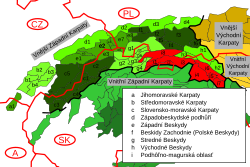Naming conventions
The division is largely (with many exceptions) undisputed at the lowest level (except for the Ukrainian part), but various divisions are given for the higher levels, especially for the penultimate level. A geomorphological division has been used as much as the data was available; other new physiogeographic divisions were used in other cases. Where the classification of a higher level "title" is known/sure, it is added at the end of the name in brackets, e.g. "(subprovince)".
- Taxonomy
The names are also given in the language of the corresponding country and marked by the ISO 3166-1 alpha-2 country codes:
The most confusing and diverse is the classification of the Beskids, including the Western Beskids, the Central Beskids and the Eastern Beskids. Their geologic features are fairly distinct, but multiple traditions, languages, and nationalities have developed overlapping variants for the divisions and names of these ranges.
In Romania, it is usual to divide the Eastern Carpathians in Romanian territory into three formal groups (northern, central, southern), instead in Outer and Inner sections of Eastern Carpathians. The Romanian approach is shown by adding the following abbreviations to the names of units within Romania:
A similar standard (grouping of outer and inner sections) is traditionally applied within broader use of the term "Wooded Carpathians", that encompasses all mountain ranges within the central section of Outer Eastern Carpathians, including Eastern Beskids with Polonynian Mountains , and also all mountains within the northern section of Inner Eastern Carpathians, including Vihorlat-Gutin Area and Maramureș-Rodna Area.
The Transylvanian Plateau is encircled by, and geologically a part of, the Carpathians. But it is not a mountainous region and its inclusion is disputed in some sources. Its features are included below.
The Serbian Carpathians are sometimes considered part of the Southern Carpathians (together with the Banat Mountains), sometimes not considered part of the Carpathians at all. They're included below.
The regions of Outer Subcarpathia lay outside the broad arc of the entire formation and are usually listed as part of the individual divisions of the Carpathian Mountains, i.e. of Western Carpathians, Eastern Carpathians, etc. With the difficulty of finding their exact subdivisions, they are given only as a list of the final units (mountains etc.) from the west to the east and south, in a separate listing at the end.

The Prešov Region, also Priashiv Region, is one of the eight Slovak administrative regions and consists of 13 districts (okresy) and 666 municipalities, 23 of which have town status. The region was established in 1996 and is the most populous of all the regions in Slovakia. Its administrative center is the city of Prešov.
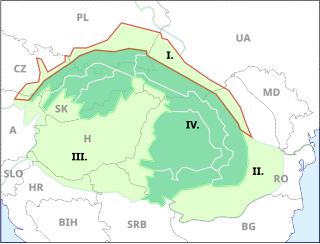
Outer Subcarpathia denotes the depression area at the outer base of the Carpathian arc, including foothills of the Outer Western Carpathians and Outer Eastern Carpathians. It stretches from northeastern Austria, through eastern Czech Republic, southern Poland, western Ukraine and northeastern Romania.

The Beskids or Beskid Mountains are a series of mountain ranges in the Carpathians, stretching from the Czech Republic in the west along the border of Poland with Slovakia up to Ukraine in the east.
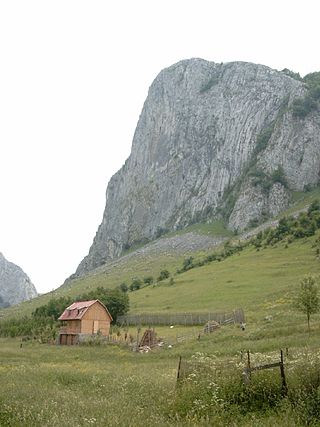
The Apuseni Mountains is a mountain range in Transylvania, Romania, which belongs to the Western Romanian Carpathians. The highest peak is the Bihor Peak at 1,849 metres (6,066 ft). The Apuseni Mountains have about 400 caves.

The Slovak Ore Mountains are an extensive mountain range within the Carpathian Mountains, located mostly in Slovakia's Spiš and Gemer region, with a small part in northern Hungary. It is the largest mountain range in Slovakia. Geomorphologically, the Slovak Ore Mountains belong to the Inner Western Carpathians.

Eastern section of the Western Beskids are a set of mountain ranges spanning the southern Polish and northern Slovak border. They constitute an eastern section of the Western Beskids, within the Outer Western Carpathians.

The Moravian-Silesian Beskids is a mountain range in the Czech Republic with a small part reaching to Slovakia. It lies on the historical division between Moravia and Silesia, hence the name. It is part of the Western Beskids within the Outer Western Carpathians.

The Bukovec Mountains is a flysch mountain range in north-eastern Slovakia, part of the Eastern Beskids of the Outer Eastern Carpathians.

This article gives an overview of the geomorphological division of Slovakia. It is ordered in a hierarchical form, belonging to the Alps-Himalaya System and to the sub-systems of the Carpathian Mountains and of the Pannonian Basin. These subsystems are subsequently divided into provinces, sub-provinces and areas.
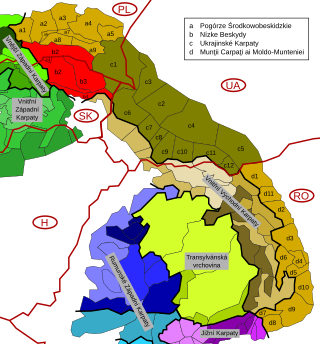
The Low Beskids or Central Beskids are a mountain range in southeastern Poland and northeastern Slovakia. They constitute a middle (central) section of the Beskids, within the Outer Eastern Carpathians.

The Western Beskids are a set of mountain ranges spanning the Czech Republic, Slovakia, and Poland. Geologically the Western Beskids are part of the Outer Western Carpathians.

The Slovak-Moravian Carpathians are the mountain ranges along the border of the Czech Republic and Slovakia. Before the Treaty of Trianon in 1920, it was known in Hungarian as Magyar-morva határhegység 'the Hungarian-Moravian border mountains'.
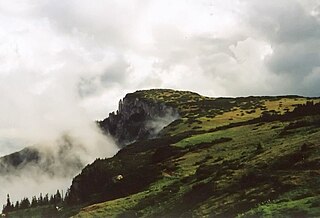
The Bistrița Mountains are mountain ranges in northern central Romania.

The Vihorlat-Gutin Area is a region of mountain ranges ranging from eastern Slovakia, through western Ukraine, into northern Romania.

The Podhale-Magura Area — is a geomorfologic region of mountain ranges in northern Slovakia and southern Poland, belonging to the Outer Western Carpathians within the Carpathian Mountains system.

The Moldavian-Muntenian Carpathians are a group of mountain ranges in Romania. These ranges are considered part of the Outer Eastern Carpathians. Within Romania, however, it is traditional to divide the Eastern Romanian Carpathians into three geographical groups, instead in Outer and Inner Eastern Carpathians:

The Central Beskidian Piedmont is a geographical region in southeastern Poland. It lies north of the Central Beskids, and belongs to the Outer Eastern Carpathians, representing the northernmost region of the Carpathians.

Central section of the Western Beskids are a set of mountain ranges spanning the southern Polish and northern Slovak border. They constitute a section of the Western Beskids, within the Outer Western Carpathians.

The Orava Highlands is a range of small mountains in the Žilina Region of north central Slovakia, part of the Outer Western Carpathians. In Slovakia these hills are considered part of the Central Beskids; in Poland they're considered Western Beskids.
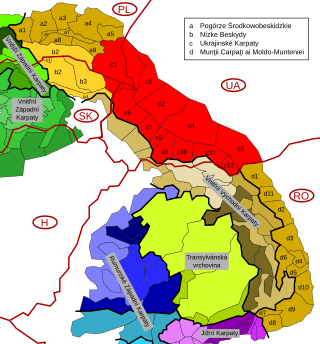
The Eastern Beskids or Eastern Beskyds are a geological group of mountain ranges of the Beskids, within the Outer Eastern Carpathians. As a continuation of the Central Beskids, this mountain range includes the far southeastern corner of Poland, the far eastern corner of Slovakia, and stretches southward through western parts of Ukraine, up to the border of Romania.
This page is based on this
Wikipedia article Text is available under the
CC BY-SA 4.0 license; additional terms may apply.
Images, videos and audio are available under their respective licenses.







